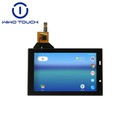IAs an important chemical and biological experimental instrument, automatic analyser has been widely used in medical diagnosis, environmental monitoring, pharmaceutical industry and other fields. With the continuous development of science and technology, the performance and functions of automatic analyser are also constantly upgraded and improved. Among them, the application of capacitive touch screen technology has brought a revolutionary change for automatic analysers. In this paper, we will discuss the application of capacitive touch screen in automatic analyser.
II. capacitive touch screen technology
Capacitive touch screen is a touch screen technology based on the principle of electric field induction. When the user's finger or stylus contact capacitive touch screen, will change the electric field distribution around the touch point, thus triggering a series of electrical signal changes in the touch screen controller. These electrical signals after processing, can be converted into the touch point coordinates of information, and thus achieve the user and the screen interactive operation.
Capacitive touch screen technology has many advantages, such as high stability, fast response speed, good durability, support for multi-touch and so on. In addition, the appearance and feel of capacitive touch screen is very good, and can provide a good interactive experience with the user.
III. capacitive touch screen in the automatic analyser applications
Human-computer interaction interface: capacitive touch screen in the automatic analyser as a human-computer interaction interface, provides an intuitive, easy-to-use interface. Users can easily perform various operations through the capacitive touch screen, such as selecting experimental projects, setting parameters, starting and stopping experiments. This intuitive operation greatly improves the efficiency of the experiment and reduces the learning cost of the user.
Real-time monitoring and feedback: The capacitive touch screen can display the experimental process and results in real time, and provide users with real-time feedback and prompts. For example, when an abnormal situation occurs during the experiment, the capacitive touch screen can immediately display an alarm message to remind the user to take appropriate measures. In addition, through the capacitive touch screen, users can also view the historical data and graphs of the experiment in order to analyse and evaluate the results.
Multi-touch function: Capacitive touch screen supports multi-touch function, which means that users can use multiple fingers or stylus to operate at the same time. In an auto analyser, multi-touch functionality can be used to select multiple experimental parameters at the same time, quickly zoom in and out and move experimental images, and more. This rich operation improves the flexibility and customisability of experiments and meets the diverse needs of users.
Customised interface design: Capacitive touchscreens support high-definition resolution display, which can provide richer and more detailed interface elements. According to the needs of different users, the interface design can be customized and personalized, including icons, backgrounds, colours and so on. This customised design makes the autoanalyser more personalised and attractive, increasing user satisfaction.
Reduced operating difficulty: Traditional autoanalysers are usually operated using buttons or knobs, requiring users to be familiar with the functions of various buttons and knobs. Capacitive touchscreens simplify operation by simply touching the screen. This greatly reduces the difficulty of operation, reduces the probability of user error, and improves the accuracy and reliability of the experiment.
Enhanced user experience: Capacitive touch screen has a good sense of touch and visual effects, providing users with a smooth, natural interactive experience. Through the capacitive touch screen, users can easily complete a variety of operations and get timely feedback and prompts during the experiment. This good user experience helps to improve users' work efficiency and satisfaction.
Scalability: With the continuous progress of science and technology, capacitive touch screen technology is also evolving. In the future, capacitive touch screen will be more intelligent and multi-functional to meet more diversified user needs. By upgrading the capacitive touch screen technology, the automatic analyser will have more advanced functions and expandability, and further improve its experimental performance and intelligence level.
In summary, the application of capacitive touch screen in automatic analyser has the advantages of human-computer interaction interface, real-time monitoring and feedback, multi-touch function, customized interface design, reduced operating difficulty, enhanced user experience and scalability. With the continuous innovation and development of technology, capacitive touch screen will play a more important role in autoanalyser, and promote the development of autoanalyser to a more intelligent and humane direction. At the same time, it also provides a useful reference and reference for the research and application in other fields.




